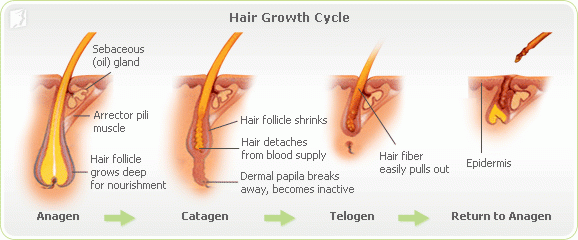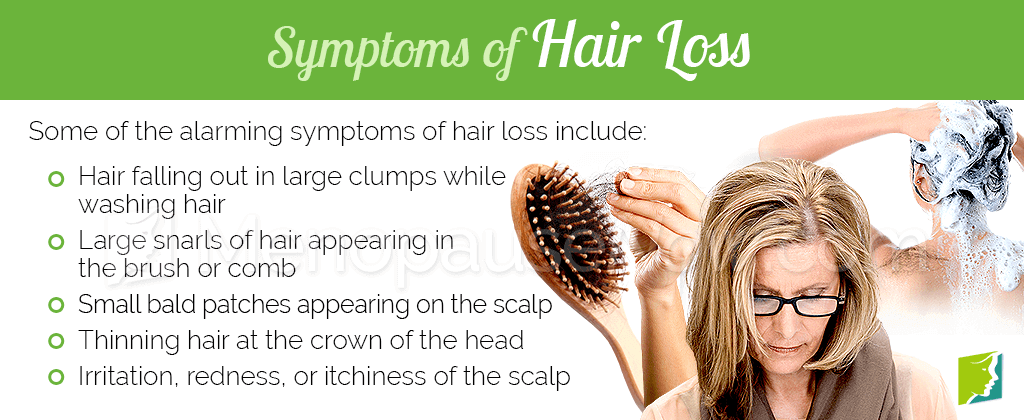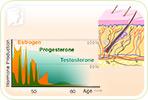Did You Know?
Healthy hair grows at a rate of about half an inch per month.
Hair loss can be one of the more alarming symptoms of menopause, since a woman's hair can be associated with her femininity, sexuality, and individual sense of style. Unfortunately, it is also one of the most common symptoms, with roughly half of all menopausal women experiencing some degree of hair loss. This can be an incredibly frustrating and concerning symptom with which to cope.
The life cycle of hair can be interrupted in a variety of fashions. Read on to learn more about hair loss, including the growth process under normal circumstances, how hair is lost, and the different types of hair loss that can affect women.
How Hair Grows
The head has approximately 100,000 hairs at any given time. Hair is made out of keratin, a protein that also forms the nails and outer layer of skin.
Above the surface, the part that is brushed and styled, each strand of hair is actually dead tissue secreted by hair follicles that exist below the scalp's surface. This visible section is called the hair shaft.
Hair remains on the head between two and six years, during which time it grows continually at a rate of about a half inch every month. This growing phase is known as anagen. There is also a resting phase known as telogen, about three months in duration, in which the hair stops growing. After this phase, the strand of hair falls out.
It is normal to lose 50 - 100 hairs each day. These are constantly regenerated by hair follicles. However, it is possible for a far greater loss of hair to occur, particularly in women in the menopause transition.

Keep reading to learn more about how hair is lost as well as the different types of hair loss menopausal women may face.
How Hair Is Lost
During menopause, if hair growth is normal, up to 15% of hairs on a woman's head are in the telogen phase, or no longer growing. At this time, the hair has detached from the hair follicle and is easily removed from the head. The hair follicle shrinks to rest for approximately three months before re-entering anagen and growing a new hair shaft, which pushes the old hair shaft out as it becomes larger, leading to a loss of the old strand.
When hormone levels are out of balance, which is typical during menopause, greater hair loss can occur. Keep reading to learn more about the symptoms of hair loss in order to recognize if it is more than normal, healthy hair loss.
Symptoms of Hair Loss
It may be difficult for a woman to tell if she is losing hair at a normal rate or if her hair shedding is a more serious condition. The following symptoms are indicative that a woman could be experiencing severe hair loss and may want to seek treatment:
- Hair falling out in large clumps when washed
- Large snarls of hair coming out in the brush or comb
- Small bald patches appearing on the scalp
- Red, itchy, or oily scalp
- Noticeable hair thinning occurring on the front, sides, or top of head
Continue reading below for a description of the different types of hair loss a woman may encounter.

Types of Hair Loss
Not all hair loss is the same. Because it can be caused by a variety of factors, there are several different forms it can take. When they hear hair loss, many people automatically picture male pattern baldness, which is characterized by a receding hairline and bald patch on top of the head. However, in women, hair loss does not typically appear in this way; rather, hair thinning is much more common than bald spots.
Types of Hair Loss
Androgenic alopecia
This is the most common form of hair loss to affect women. Thought to be caused by changes in hormone levels, it is most frequently seen in menopausal women menopause and is characterized by overall thinning as well as a bald spot at the crown; also called female pattern baldness.
Telogen effluvium
This occurs when sudden stress or malnutrition causes a large number of hair follicles to enter the telogen phase at the same time. A couple of months after, when they reenter anagen, a mass shedding of hair is triggered.
Alopecia areata
Occasionally, a woman will lose her hair in spots or patches rather than the more common subtle thinning. This is thought to be an autoimmune disease in which the body attacks its own hair follicles, thinking them to be foreign bodies. A key symptom of this condition is hair loss all over the body, not just the scalp.
Trichotillomania
This is an obsessive-compulsive disorder that involves the pulling of one's own hair that is most commonly seen in younger women - typically pre-teens or teenagers - but can be triggered by the anxiety typical of menopause.
Traction alopecia
Hair loss caused by extreme stress to the hair through hairstyles that are harsh on the follicles, such as braiding, cornrows, or extensions.
How female hair loss differs from male-pattern hair loss
Did You Know?
Not all women will experience alopecia in postmenopause, but almost all will experience mild thinning.
- Progression is slower
- Hair loss is diffuse
- A receding hairline is rare
- Hair loss worsens during menopause
- It is usually age-related rather than hereditary
With a clear understanding of hair loss during menopause, now is the ideal time to begin reading about the causes of hair loss to gain the understanding necessary to effectively treat this symptom of menopause.
Sources
- National Health Service UK. (2015). Women and hair loss: coping tips. Retrieved April 14, 2016, from http://www.nhs.uk/livewell/hairloss/pages/womenandhairloss.aspx
- National Institutes of Health. (2014). Female pattern baldness: MedlinePlus Medical Encyclopedia. Retrieved April 14, 2016, from http://www.nlm.nih.gov/medlineplus/ency/article/001173.htm
- Riedel-Baima, B. & Riedel, A. (2008). Female pattern baldness may be triggered by low oestrogen to androgen ratio. Endocrine regulations, 42(1), 13-16. Retrieved from http://www.ncbi.nlm.nih.gov/pubmed/18333699



